标签:
1.Instance Constructors and Classes (Reference Types)
Constructors methods :
1.allow an instance of a type to be initialized to a good state.
2.are always called .ctor (for constructor) in a method definition metadata table.
3.When creating an instance of a reference type, memory is allocated for the instance’s data fields, the object’s overhead fields (type object pointer and sync block index) are initialized, and then the type’s instance constructor is called to set the initial state of the object.
3.When constructing a reference type object, the memory allocated for the object is always zeroed out before the type’s instance constructor is called. Any fields that the constructor doesn’t explicitly overwrite are guaranteed to have a value of 0 or null.
4.instance constructors are never inherited. That is, a class has only the instance constructors that the class itself defines.
Because instance constructors are never inherited, you cannot apply the following modifiers to an instance constructor: virtual, new, override, sealed, or abstract.
5.If you define a class that does not explicitly define any constructors, the C# compiler defines a default (parameterless) constructor for you whose implementation simply calls the base class’s parameterless constructor.
![]() =
=![]()
If the class is abstract, the compiler-produced default constructor has protected accessibility;otherwise, the constructor is given public accessibility.
If the base class doesn’t offer a parameterless constructor, the derived class must explicitly call a base class constructor or the compiler will issue an error.
If the class is static (sealed and abstract), the compiler will not emit a default constructor at all into the class definition.
6.define several instance constructors. Each constructor must have a different signature,and each can have different accessibility.
7.For verifiable code, a class’s instance constructor must call its base class’s constructor before accessing any of the inherited fields of the base class.
The C# compiler will generate a call to the default base class’s constructor automatically if the derived class’s constructor does not explicitly invoke one of the base class’s constructors.
Ultimately, System.Object’s public,parameterless constructor gets called. This constructor does nothing—it simply returns. This is because System.Object defines no instance data fields, and therefore its constructor has nothing to do.
8.In a few situations, an instance of a type can be created without an instance constructor being called.
In particular, calling Object’s MemberwiseClone method allocates memory, initializes the object’s overhead fields, and then copies the source object’s bytes to the new object.
Also, a constructor is usually not called when deserializing an object with the runtime serializer. The deserialization code allocates memory for the object without calling a constructor by using the System.Runtime.Serialization.FormatterServices type‘s GetUninitializedObject or GetSafeUninitializedObject methods.
9.You should not call any virtual methods within a constructor that can affect the object being constructed.
The reason is if the virtual method is overridden in the type being instantiated, the derived type’s implementation of the overridden method will execute,but all of the fields in the hierarchy have not been fully initialized.
Calling a virtual method would therefore result in unpredictable behavior.
compiling:
1.a simple syntax that allows the initialization of fields defined within a reference type when an instance of the type is constructed
![]()
examine the Intermediate Language (IL) for SomeType’s constructor method (also called .ctor)
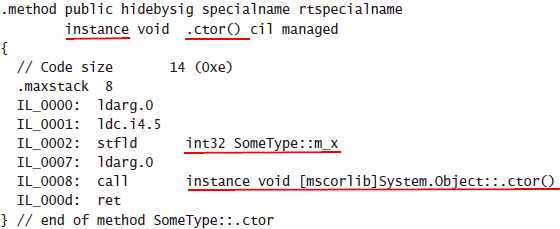
SomeType’s constructor contains code to store a 5 into m_x and then calls the base class’s constructor.
In other words, the C# compiler allows the convenient syntax that lets you initialize the instance fields inline and translates this to code in the constructor method to perform the initialization.
2. you should be aware of code explosion.
The compiler initializes any fields by using the convenient syntax before calling a base class’s constructor to maintain the impression that these fields always have a value as the source code appearance dictates.

When the compiler generates code for the three constructor methods.
the beginning of each method includes the code to initialize m_x, m_s, and m_d.
then, the compiler inserts a call to the base class’s constructor.
then, the compiler appends to the method the code that appears in the constructor methods.
For example, the code generated for the constructor that takes a String parameter includes the code to initialize m_x, m_s, and m_d, call the base class’s (Object’s) constructor, and then overwrite m_d with the value 10. Note that m_b is guaranteed to be initialized to 0 even though no code exists to explicitly initialize it.
3.The potential problem occurs when a base class’s constructor invokes a virtual method that calls back into a method defined by the derived class.
If this happens, the fields initialized by using the convenient syntax have been initialized before the virtual method is called.
4.If you have several initialized instance fields and a lot of overloaded constructor methods, you should consider defining the fields without the initialization, creating a single constructor that performs the common initialization, and having each constructor explicitly call the common initialization constructor.
This approach will reduce the size of the generated code.
example:there are three constructors in the preceding class, the compiler generates the code to initialize m_x, m_s, and m_d three times—once per constructor.
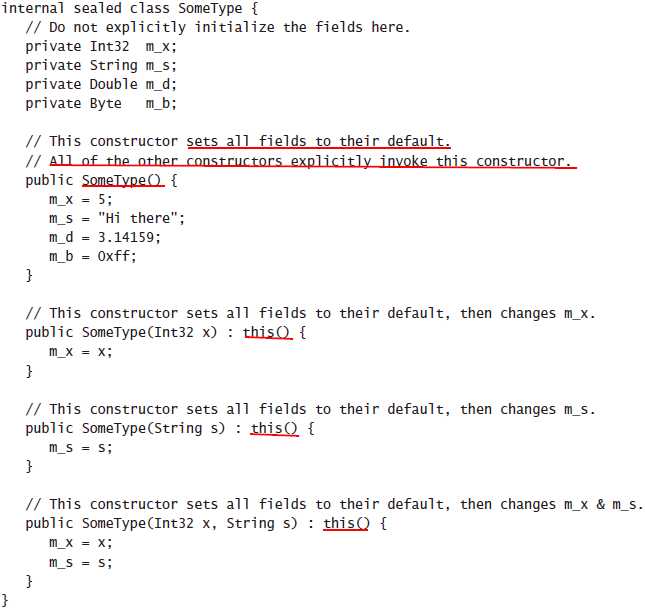
2.Instance Constructors and Structures (Value Types)
Value type (struct) constructors:
work quite differently from reference type (class) constructors.
1.The common language runtime (CLR) always allows the creation of value type instances, and there is no way to prevent a value type from being instantiated.
For this reason, value types don’t actually even need to have a constructor defined within them, and the C# compiler doesn‘t emit default parameterless constructors for value types.
2.Strictly speaking, value type fields are guaranteed to be 0/null when the value type is a field nested within a reference type. However, stack-based value type fields are not guaranteed to be 0/null.
For verifiability, any stack-based value type field must be written to prior to being read. If code could read a value type’s field prior to writing to the field, a security breach is possible.
C# and other compilers that produce verifiable code ensure that all stack-based value types have their fields zeroed out or at least written to before being read so that a verification exception won’t be thrown at run time.
For the most part,this means that you can assume that your value types have their fields initialized to 0, and you can completely ignore everything in this note.
3.although C# doesn’t allow value types with parameterless constructors, the CLR does.
So if the unobvious behavior described earlier doesn’t bother you, you can use another programming language (such as IL assembly language) to define your value type with a parameterless constructor.
Because C# doesn’t allow value types with parameterless constructors, compiling the following type produces the following message: error CS0573: ‘SomeValType.m_x‘: cannot have instance field initializers in structs.

4.any constructors that you do have for a value type must initialize all of the type’s fields.
because verifiable code requires that every field of a value type be written to prior to any field being read

When compiling this type, the C# compiler produces the following message: error CS0171:Field ‘SomeValType.m_y‘ must be fully assigned before control leaves the constructor.
To fix the problem, assign a value (usually 0) to y in the constructor. or do like this below

this represents an instance of the value type itself and you can actually assign to it the result of newing up an instance of the value type, which really just zeroes out all the fields.
In a reference type’s constructor, this is considered read-only, so you cannot assign to it at all.
compliling:
1.To construct a Rectangle, the new operator must be used, and a constructor must be specified.
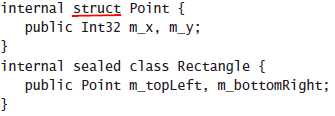
In this case, the default constructor automatically generated by the C# compiler is called.
When memory is allocated for the Rectangle, the memory includes the two instances of the Point value type. For performance reasons, the CLR doesn’t attempt to call a constructor for each value type field contained within the reference type. But as I mentioned earlier, the fields of the value types are initialized to 0/null.
A value type’s instance constructor is executed only when explicitly called.
2.The CLR does allow you to define constructors on value types. The only way that these constructors will execute is if you write code to explicitly call one of them.
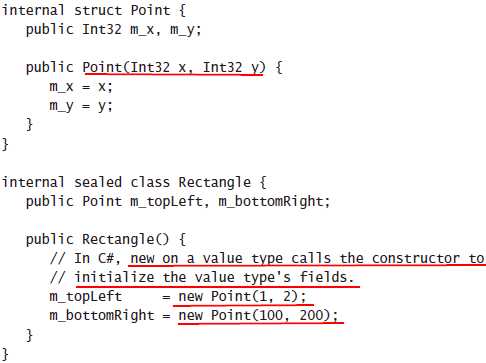
A value type’s instance constructor is executed only when explicitly called. So if Rectangle’s constructor didn’t initialize its m_topLeft and m_bottomRight fields by using the new operator to call Point’s constructor, the m_x and m_y fields in both Point fields would be 0.
many compilers will never emit code to call a value type’s default constructor automatically, even if the value type offers a parameterless constructor.because to improve the run-time performance of the application,the C# compiler doesn’t automatically emit this code.
To have a value type’s parameterless constructor execute, the developer must add explicit code to call a value type’s constructor.
3.C# purposely disallows value types from defining parameterless constructors to remove any confusion a developer might have about when that constructor gets called.
If the constructor can’t be defined, the compiler can never generate code to call it automatically.
Without a parameterless constructor, a value type’s fields are always initialized to 0/null.
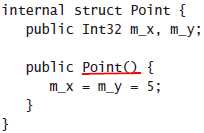
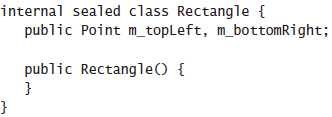
C# doesn’t allow a value type to define a parameterless constructor. So the previous code won’t actually compile. The C# compiler produces the following message when attempting to compile that code: error CS0568: Structs cannot contain explicit parameterless constructors.
3.Type Constructors
type constructors:
also known as static constructors,class constructors, or type initializers
1.can be applied to interfaces (although C# doesn’t allow this), reference types, and value types.
2.are used to set the initial state of a type. By default, types don’t have a type constructor defined within them.
If a type has a type constructor, it can have no more than one.
In addition, type constructors never have parameters
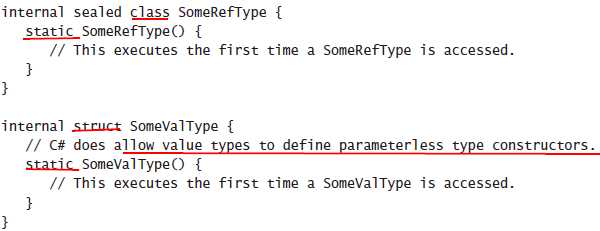
type constructors just as you would parameterless instance constructors,except that you must mark them as static.
3.type constructors should always be private,C# makes them private for you automatically.
In fact, if you explicitly mark a type constructor as private (or anything else) in your source code, the C# compiler issues the following error: error CS0515: ‘SomeValType.SomeValType()‘: access modifiers are not allowed on static
constructors.
Type constructors should be private to prevent any developer-written code from calling them; the CLR is always capable of calling a type constructor.
4.Although you can define a type constructor within a value type, you should never actually do this
because there are times when the CLR will not call a value type’s static type constructor
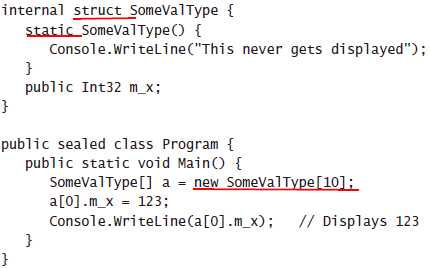
5.The calling of a type constructor is a tricky thing. When the just-in-time (JIT) compiler is compiling
a method, it sees what types are referenced in the code. If any of the types define a type constructor,
the JIT compiler checks if the type’s type constructor has already been executed for this AppDomain.
If the constructor has never executed, the JIT compiler emits a call to the type constructor into the
native code that the JIT compiler is emitting. If the type constructor for the type has already executed,
the JIT compiler does not emit the call because it knows that the type is already initialized.
4.Operator Overload Methods
5.Conversion Operator Methods
6.Extension Methods
7.Partial Methods
标签:
原文地址:http://www.cnblogs.com/panpanwelcome/p/5685590.html